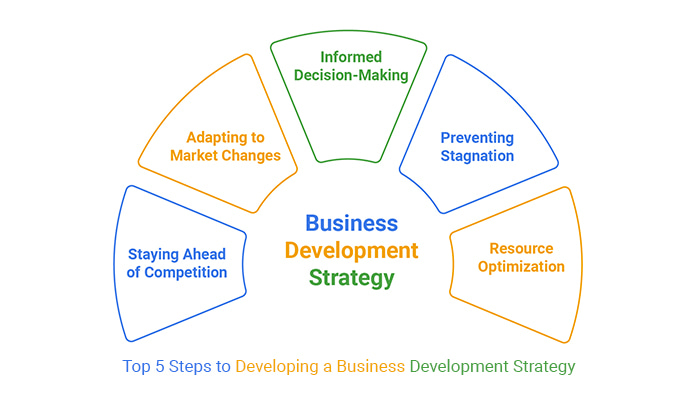Business Development
Business development plays critical role in driving growth and success. Our team of experts is dedicated to helping your organization identify, pursue, and capitalize on new opportunities. Whether you're a startup looking to expand your market reach or an established enterprise seeking to diversify your revenue streams, we provide strategic guidance and practical solutions to fuel your business growth.
The business development process can be divided into three critical stages: Attract Prospects, Build Engagement, and Turn Opportunities into Clients.
Traditionally, the first two stages are marketing-driven, while the final stage focuses on sales. Historically, business development teams primarily sought new distribution channels or marketing partners.
However, in today’s evolving landscape, the lines between marketing, sales, and business development are becoming increasingly blurred. Many organizations now refer to the entire marketing and sales process as business development, leading to some confusion.
At SS Solutions, we help you navigate these changes by implementing a streamlined, modern approach to business development, ensuring all stages work cohesively to drive results.

The three stages of the business development funnel
Importance of Business Development
Revenue Growth
By identifying new markets, customers, and opportunities, Business Development (BD) drives the organization’s growth.
Strategic Partnerships
BD helps in building valuable partnerships with stakeholders, suppliers, distributors, and other key players in the industry.
Market Expansion
BD helps companies enter new markets and sectors by evaluating market trends, customer needs, and potential competitors.
Competitive Edge
It ensures that businesses stay ahead of the competition by leveraging new technologies, strategies, and innovations.

Market Research and Analysis: Gain valuable insights into industry trends, competitor landscapes, and emerging market opportunities. Strategic Planning: Develop actionable strategies to achieve your business objectives, whether it's expanding into new markets, launching new products/services, or increasing market share.
Partnership Development: Identify and cultivate strategic partnerships that enhance your competitive advantage and drive mutual growth. Lead Generation and Conversion: Implement targeted marketing and sales initiatives to generate qualified leads and convert them into profitable customers. Relationship Management: Nurture and strengthen relationships with key stakeholders, clients, and partners to foster long-term loyalty and retention. Performance Monitoring and Optimization: Track key performance metrics and refine your business development strategies based on data-driven insights to maximize ROI and achieve sustainable growth.
Partner with SS Solutions to unlock new growth opportunities and propel your business to greater heights!
Key Activities in Business Development
Market Research and Analysis
Understanding the market landscape is crucial to identifying opportunities:
- Market Trends: Keeping up with industry trends, customer needs, and market demands.
- Competitive Analysis: Studying competitors to identify gaps in the market or competitive advantages.
- Customer Segmentation: Identifying and understanding target customer groups to tailor business strategies.
Strategic Planning
Once opportunities are identified, the next step is developing a strategy:
- Opportunity Assessment: Analyzing and prioritizing opportunities based on potential growth, risk, and resource requirements.
- Goal Setting: Defining clear business goals, whether expanding into new markets, increasing sales, or entering into new partnerships.
- Strategic Roadmap: Outlining the steps necessary to achieve business objectives and secure new opportunities.
Lead Generation and Sales
Business development works closely with sales and marketing to generate new leads and drive revenue:
- Outbound Lead Generation: Reaching out to potential customers through cold calls, emails, or networking.
- Inbound Lead Nurturing: Using digital marketing strategies like content marketing, social media, and SEO to attract and nurture leads.
- Sales Funnel Management: Moving prospects through the sales funnel by building relationships, addressing concerns, and converting leads into clients.
Building Strategic Partnerships
Forming alliances or partnerships can open new doors for market entry, product development, or joint ventures:
- Vendor and Supplier Relationships: Negotiating and managing relationships with vendors, suppliers, or distributors.
- Joint Ventures and Alliances: Partnering with other businesses for mutual benefit, such as expanding market reach or combining expertise.
- Mergers and Acquisitions (M&A): Exploring opportunities for acquisitions, mergers, or other strategic alliances that can accelerate growth.
Product or Service Development
Understanding market needs and collaborating with product development teams to ensure offerings meet customer demands:
- Market Fit: Ensuring that the product or service meets customer needs and stands out in the marketplace.
- Feedback Loop: Gathering and analyzing customer feedback to improve the product or service.
- Innovation: Identifying areas where the company can innovate or expand offerings to drive growth.
Networking and Relationship Building
Relationships are at the heart of business development:
- Networking Events: Attending industry conferences, trade shows, and events to build contacts and foster relationships.
- Customer Relationship Management (CRM): Using CRM tools to manage and track interactions with existing and potential clients.
- Follow-ups: Keeping in touch with potential clients and partners through ongoing communication and relationship management.
A well-planned business development strategy is key to growing a company’s market presence and revenue. Some common strategies include:
- Market Penetration: This strategy focuses on increasing the market share of existing products in current markets. Tactics may include:
- Aggressive marketing campaigns
- Price adjustments to attract more customers
- Enhancing product features to outperform competitors
- Market Expansion (or Market Development): Market expansion involves entering new markets, either geographically or demographically. Key steps include:
- Identifying untapped or underserved markets
- Adjusting the product/service to meet the new market’s demands
- Developing new distribution channels
- Product Diversification: This involves developing new products or services to offer alongside existing ones. Diversification can reduce dependency on a single market segment and improve long-term growth prospects:
- Vertical diversification: Offering products related to the current supply chain.
- Horizontal diversification: Introducing new, unrelated products to the existing customer base.
- Strategic Partnerships and Alliances: Forming alliances with other businesses to gain access to their markets, resources, or expertise is a common strategy in BD:
- Co-marketing agreements
- Joint ventures for entering new geographic markets or developing new technologies
- Licensing and franchising agreements
- Digital Transformation and Innovation: Leveraging technology for business development is essential in today's digital era:
- Investing in eCommerce and online platforms to reach a global audience.
- Using data analytics and AI to identify trends, opportunities, and customer behaviour.
- Innovating with new digital products or services to meet evolving market demands.

Effective strategies for business development success
Business Development Tools and Technologies
Customer Relationship Management (CRM) Tools
Business development professionals use various CRM tools to manage customer relationships, sales pipelines, and lead generation:
- Salesforce: One of the most popular CRMs, helps manage customer relationships, sales pipelines, and lead generation.
- HubSpot: An inbound marketing, sales, and service software with CRM capabilities.
- Zoho CRM: A more affordable CRM solution, popular with small and medium-sized businesses.
Market Research and Competitive Intelligence Tools
These tools provide insights into industries and competitors:
- Gartner: Provides insights into industries and competitors.
- CB Insights: A business analytics platform that provides information about startups, investors, and emerging trends.
- Hoovers/D&B: A business database used for research on companies and markets.
Project Management and Collaboration Tools
These tools help manage BD projects and ensure tasks are completed on time:
- Trello/Asana: Tools for managing BD projects, ensuring tasks are completed on time.
- Slack/Microsoft Teams: Real-time collaboration tools to facilitate communication between BD and other departments.
- Google Workspace: Cloud-based tools for sharing and collaborating on documents, spreadsheets, and presentations.
Networking Tools
Networking tools help establish connections with key decision-makers:
- LinkedIn Sales Navigator: A premium LinkedIn tool that helps find leads and establish connections with key decision-makers.
- Zoom/Teams: Virtual meeting platforms used to conduct presentations, negotiations, and relationship-building activities.
Data Analytics and Reporting Tools
These tools track KPIs and assess inbound marketing efforts:
- Google Analytics: Tracks website performance, helping assess inbound marketing efforts.
- Power BI/Tableau: Data visualization tools to track KPIs, business performance, and market trends.
- Klipfolio: A customizable dashboard for business performance metrics, often used for tracking growth and leads.
